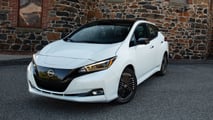
Nissan has just announced the 2025 Leaf in the U.S., which is a carry-over model year with no noticeable changes.
The Japanese EV is still available in two trim levels: S and SV Plus. The S is equipped with a 40-kilowatt-hour battery and, according to the manufacturer, has an EPA-estimated range of up to 149 miles. The SV Plus has a bigger, 60-kWh battery for up to 212 miles of EPA range.
Get Fully Charged
Nissan Leaf is an EV grandpa
The first Nissan Leaf was launched in the U.S. in December 2010 as a 2011 model year. After a few small upgrades, including higher-capacity batteries, more powerful motors and chargers, the model lived up to 2024. It's one of the longest-living EV models on the market, but it's clearly fading.
The difference between the two versions, both of which are front-wheel drive, is power output. The Nissan Leaf S has a 110-kilowatt (147 horsepower) electric motor, while the SV Plus has a 160-kW one (214 horsepower).
The entry-level 2025 Nissan Leaf S starts at an MSRP of $28,140, while the SV Plus costs $8,050 more—$36,190. The prices are the same as for the 2024 model year. However, the destination charge is slightly higher—$1,140 versus $1,095 previously.


When it comes to pricing, the 2024 model year is qualified for the $3,750 federal tax credit, while the 2025 model year is not, at least not yet, but it might get qualified at a later date.
Nissan explained in its press release: "At this time, the 2025 Nissan LEAF is not eligible for the Federal EV tax credit under Internal Revenue Code Section 30D based on final regulations released by the Internal Revenue Service on May 3, 2024. However, eligible customers may still qualify for up to $3,750 in potential Federal EV tax credits on any remaining new 2024 LEAF vehicles that were manufactured in 2024 if purchased and delivered to the customer before January 1, 2025. Customers should consult their tax advisors to determine eligibility."
Prices
| Model | Base Price | Dest. Charge | Tax Credit | Effective Price |
| 2024 Nissan Leaf S (40 kWh) 16-in | $28,140 | +$1,095 | $3,750 | $25,485 |
| 2024 Nissan Leaf SV Plus (60 kWh) 17-in | $36,190 | +$1,095 | $3,750 | $33,535 |
| 2025 Nissan Leaf S (40 kWh) 16-in | $28,140 | +$1,140 | N/A | $29,280 |
| 2025 Nissan Leaf SV Plus (60 kWh) 17-in | $36,190 | +$1,140 | N/A | $37,330 |
* eligibility for the federal tax credit might change at a later point
The 2025 Leaf comes standard with Nissan Safety Shield 360, a suite of technologies that includes Automatic Emergency Braking with Pedestrian Detection, Blind Spot Warning and Lane Departure Warning. The SV Plus additionally gets ProPILOT Assist and Intelligent Around View Monitor feature.
Nissan covered the Leaf with EV Carefree+, which includes scheduled maintenance for three years or 36,000 miles, EV Battery Health Assurance (8-year/100,000-mile battery warranty), and 36-month/36,000-mile emergency EV Roadside Assistance.


Nonetheless, at the current pricing, the Nissan Leaf does not appear to be very compelling, and customers have a growing number of better options—new or used EVs. These include models with higher range, more power, better charging, or more features.
Let's just point out that the Nissan Leaf is still equipped with its now-outdated CHAdeMO charging system. If you find a legacy CHAdeMO charger, it will take roughly 60 minutes to recharge from a low state-of-charge to 80% and 40 minutes in the case of the base 40-kWh battery. Nissan's website says there are nearly 5,000 CHAdeMO public DC quick charging stations nationwide.
The onboard charger is much more appropriate for the task, at 6.6 kilowatts (6.0 kW output), and should easily complete the task overnight.
Basic specs
| Model | Drive | Battery (kWh) | EPA Range |
| 2024 Nissan Leaf S (40 kWh) 16-in | FWD | 40 | 149 mi |
| 2024 Nissan Leaf SV Plus (60 kWh) 17-in | FWD | 60 | 212 mi |
| 2025 Nissan Leaf S (40 kWh) 16-in | FWD | 40 | 149 mi* |
| 2025 Nissan Leaf SV Plus (60 kWh) 17-in | FWD | 60 | 212 mi* |
* EPA-estimated range numbers according to Nissan
Gallery: 2025 Nissan Leaf














